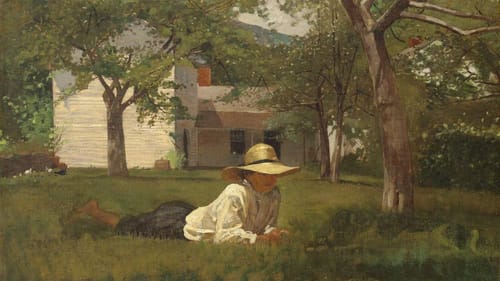Stay in the Loop
BSR publishes on a weekly schedule, with an email newsletter every Wednesday and Thursday morning. There’s no paywall, and subscribing is always free.
On looking into Winslow Homer
The Brandywine River Museum of Art presents ‘Winslow Homer: Photography and the Art of Painting’

Many consider Winslow Homer (1836-1910) the greatest American artist of the 19th century. His genre paintings, landscapes, and seascapes influenced generations (including Howard Pyle and the Wyeths). So it’s illuminating to consider him afresh in Winslow Homer: Photography and the Art of Painting, now at the Brandywine River Museum.
Originating at Maine’s Bowdoin College Museum of Art and curated by Frank H. Goodyear and Dana E. Byrd, the exhibition features 100 works in a variety of media. There are few familiar Homer images here. Rather, the curators set out to examine the artist in perspective of that developing and increasingly popular medium — photography.
Photos are something we take for granted. Images are readily available now, even overwhelming, and anyone can create them. But in the mid-19th century photographs were dazzlingly new, and artists — like the public — grappled with their impact.
When artists met photography
This chronological exhibition opens with Matthew Brady’s photographs of Abraham Lincoln and Jefferson Davis — tiny portraiture jewels set beside the Homer commercial prints that used adapted images of both men.
Another of the era’s burgeoning industries was the rise of illustrated publications due to advances in printing technology. Artists often commenced their careers as freelance commercial printmakers and illustrators, especially in New York, and Homer was one of them. The marketable works, like the 1864 series of lithographic cards (Life in Camp, 12 Scenes) seen here, were meant for collection and display in albums, like sports cards today.
As an illustrator, Homer covered the Civil War, especially actions in Virginia. The exhibition has some of his early works of arts journalism displayed alongside photographs that allowed him to capture the action as he worked in his more deliberate media. Goodyear and Byrd have an interesting premise, though some of their artist/photographer comparisons seem curatorially stretched.
Paying the bills in print
It’s surprising to observe how Homer utilized his own paintings for his subsequent illustrations. As the artist’s career progressed and he traveled to Paris and England, his work became increasingly rich in both technique and content — at times even allegorical, imbued with a deepening consideration of the universal themes evident even in early oils, like 1865’s Trooper Meditating Beside a Grave.

Homer modified some of his larger-themed paintings into more commercial images, especially in two works for Harper’s Weekly, tellingly displayed side by side with the oils on which they’re based. Waiting for an Answer (1872), a moving scene of reaping and harvest that evokes the nation’s post-Civil War mourning, evolved that same year into a wood engraving titled Making Hay. The engraving replaced Waiting’s eloquent and solitary female figure with two charming children, creating a more consumer-friendly scene. Similarly, the artist modified The Nooning (c. 1872), his evocative and well-known oil of a young boy lying in dappled sunlight, into a more mundane domestic scene that added more children and a spritely dog. It is telling to see how the artist flattened his deeper content into something more simplistic and easily digested by print purchasers or readers of mass periodicals.
Beyond the genre
Homer ceased printmaking in 1875 and moved to Maine in 1883, where he created some of his strongest and best-known works. A large masterpiece from that time — High Cliff, Coast of Maine (1894) — holds pride of place near the end of the exhibition. Though it has little to do with the exhibition’s premise, it’s a stunning addition, foreshadowing abstraction in a way seldom associated with this genre painter.
The gallery also contains a few ephemera, like Homer’s own cameras, as well as images from his collection of photographs, including Edward Muybridge’s multi-image stop-action baseball photo (Animal Locomotion, Plate 287, c. 1880), and there’s a Yale University Press catalogue.
In February, the works return to Bowdoin and the collections from which they came. Mounted with BRM’s usual elegant clarity and attention to detail, Photography and the Art of Painting continues the museum’s expanded mission to connect the region’s storied artistic traditions to the wider world of both period and contemporary art.
The exhibition falls amid the Brandywine’s highly attended seasonal offerings and a lovely exhibition of illustrated children’s books (here’s the BSR review). But once you thread your way through the influx of holiday visitors, the serene upstairs gallery, painted evocatively in “Winslow Homer greys,” awaits with a welcome respite and a fresh look at this iconic artist.
BRM offers sensory-friendly packs full of resources for visitors with a variety of needs.
You can help keep BSR going strong in 2019 and beyond. Make your gift here.
What, When, Where
Winslow Homer: Photography and the Art of Painting. Through February 17, 2019, at the Brandywine River Museum of Art, Chadds Ford, PA. (610) 388-2700 or brandywine.org/museum.
Sign up for our newsletter
All of the week's new articles, all in one place. Sign up for the free weekly BSR newsletters, and don't miss a conversation.

 Gail Obenreder
Gail Obenreder